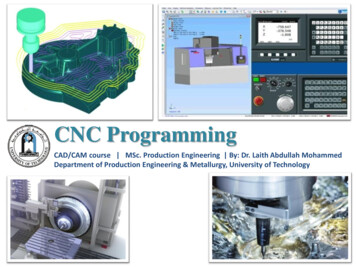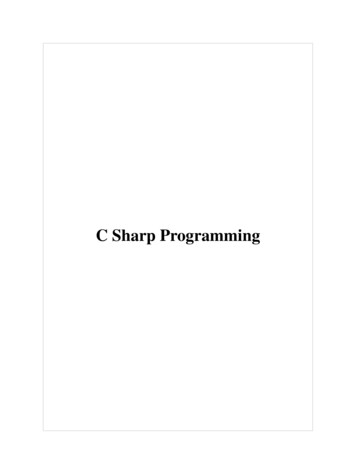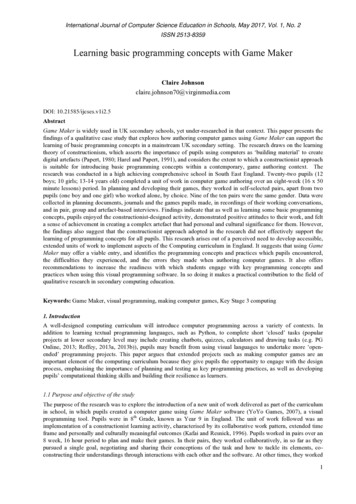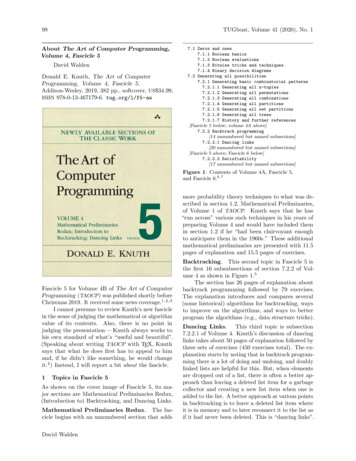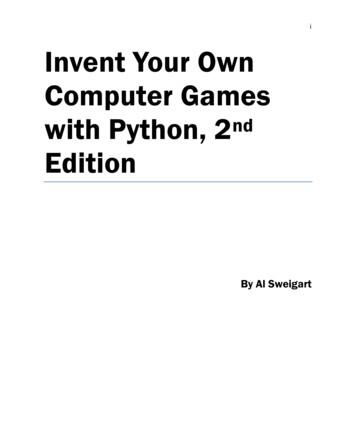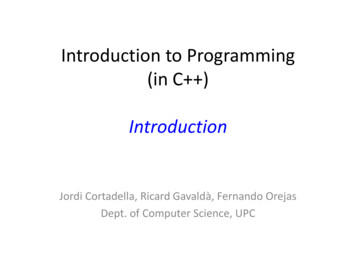
Transcription
Introduction to Programming(in C )IntroductionJordi Cortadella, Ricard Gavaldà, Fernando OrejasDept. of Computer Science, UPC
Outline Programming examples Algorithms, programming languages andcomputer programs Steps in the design of a programIntroduction to Programming Dept. CS, UPC2
First program in C #include iostream using namespace std;// This program reads two numbers and// writes their sumint main() {int x, y;cin x y;int s x y;cout s endl;}Introduction to Programming Dept. CS, UPC3
sum8 1321 sum-15 9-6 coutcinIntroduction to Programming Dept. CS, UPC4
Calculate xy Algorithm: repeated multiplicationx x x xy timesy44444Introduction to Programmingx33333i01234 Dept. CS, UPCp xi13927815
Calculate xy#include iostream using namespace std;// Input: read two integer numbers, x and y,//such that y 0// Output: write xyint main() {int x, y;cin x y;}int i 0;int p 1;while (i y) { // Repeat several times (y)i i 1;p p x;// p xi}cout p endl;Introduction to Programming Dept. CS, UPC6
Prime factors Decompose a number in prime factors– Example: input 350 output 2 5 5 7 Intuitive algorithm:– Try all potential divisors d, starting from 2 If divisible by d, divide and try again the same divisor If not divisible, go to the next divisor– Keep dividing until the number becomes 1Introduction to Programming Dept. CS, UPC7
Prime snononoyesyesnonoyesfinishwrite2557The algorithm will never write a non-prime factor. Why ?Introduction to Programming Dept. CS, UPC8
Prime factors#include iostream using namespace std;// Input: read a natural number n 0// Output: write the decomposition in prime factorsint main() {int n;cin n;int d 2;}// Variable to store divisors// Divide n by divisors from 2 in ascending orderwhile (n ! 1) {if (n%d 0) { // Check if divisiblecout d endl;n n/d;}else d d 1;}Introduction to Programming Dept. CS, UPC9
ALGORITHMS, PROGRAMMINGLANGUAGES AND COMPUTERPROGRAMSIntroduction to Programming Dept. CS, UPC10
An algorithm An algorithm is a method for solving aproblem. It is usually described as a sequenceof steps. Example: How can we find out whether anumber is prime?– Read the number (N).– Divide N by all numbers between 2 and N-1 andcalculate the remainder of each division.– If all remainders are different from zero, thenumber is prime. Otherwise, the number is notprime.Introduction to Programming Dept. CS, UPC11
A programming language A programming language is a language used todescribe instructions for a computer. What’s in a programming language?– Data (numbers, strings, structures, )– Instructions (arithmetic, sequence, repetition, ) A programming language has very strict syntaxand semantics, as it must be understood by acomputer!Introduction to Programming Dept. CS, UPC12
A computer program A computer program is an algorithm written in a in aprogramming language that executes a certain task. Examples of tasks a computer program can execute:– Calculate the square root of a number– Find the number of times the word “equation” appears ina math book– Play a music file– Find the shortest path between two citiesIntroduction to Programming Dept. CS, UPC13
A computer systemProgram(high-levellanguage)This course: Design of programs Language: C CompilerProgram(machinelanguage)LoaderInput devices(keyboard, mouse,microphone, etc.)InstructionMemoryDataMemoryOutput devices(display, printer,speakers, etc.)CPUIntroduction to Programming Dept. CS, UPC14
High-level language Computers understand very low-level instructions(machine language). Software is usually constructed using high-level languages.––––Higher productivityBetter readabilitySimpler debuggingBut some time and memory efficiency may be lost A compiler can translate a high-level language into machinelanguage automatically. There is a huge number of programming languages: C, C , Java,Pascal, PHP, Modula, Lisp, Python, Excel, Fortran, Cobol, APL, Basic,Tcl, Ruby, Smalltalk, Haskell, Perl, SQL, Prolog, Introduction to Programming Dept. CS, UPC15
Assembly and machine language(From http://en.wikipedia.org/wiki/Assembly language)Introduction to Programming Dept. CS, UPC16
STEPS IN THE DESIGN OF APROGRAMIntroduction to Programming Dept. CS, UPC17
Steps in the design of a program1.Specification–2.Design of the algorithm–3.The method for executing the task must be selected and designed insuch a way that the program is correct according to the specification.Coding in a programming language–4.The task executed by the program must be described rigorously(without ambiguities).The algorithm must be written in a programming language that canbe executed by the computer.Execution–The program must be executed with a set of examples thatreasonably cover all the possible cases of data input. If the programdoes not work properly, the algorithm will have to be redesigned.Introduction to Programming Dept. CS, UPC18
Example Design a program that– given a natural number representing a certainamount of time in seconds (N),– calculates three numbers (h, m, s) that representthe same time decomposed into hours (h),minutes (m) and seconds (s)– Example Given N 3815, Calculate h 1, m 3, s 35Introduction to Programming Dept. CS, UPC19
Specification Precondition:– Specification of the data before the program isexecuted Postcondition:– Specification of the data after the program isexecuted Example– Precondition:– Postcondition:Introduction to ProgrammingN 03600 h 60 m s N Dept. CS, UPC20
Specification Alternatively, specifications can describe the input andoutput data of a program.Input: the program reads a natural number representing anumber of seconds.Output: the program writes the same time decomposedinto hours, minutes and seconds. Specifications can be described in many ways, e.g.using plain English or formal logic propositions. Even when written in English, specifications must berigorous and unambiguous.Introduction to Programming Dept. CS, UPC21
A bad specification Precondition: N 0 Postcondition: 3600 h 60 m s N,Introduction to Programming Dept. LSI,CS, UPC22
A bad specification Does the specification really describe what theprogram is supposed to calculate? Example– Assume N 3815– The solution h 1, m 3, s 35 meets thespecification (1 3600 3 60 35 3815)– But the solutions h 0, m 30, s 2015 andh 0, m 0 and s 3815 also meet the specification.What’s wrong?Introduction to Programming Dept. CS, UPC23
A good specification Precondition: N 0 Postcondition: 3600 h 60 m s N,0 s 60, 0 m 60 The solution h 1, m 3, s 35 fulfils thespecification. The solutions h 0, m 30, s 2015 andh 0, m 0, s 3815 do not.Introduction to Programming Dept. CS, UPC24
Algorithms An algorithm:– h N / 3600– m (N mod 3600) / 60– s N mod 60(integer division)(mod: remainder) Another algorithm:––––s N mod 60x N / 60m x mod 60h x / 60 Many algorithms may exist to solve the same problem.Use the most efficient one whenever possible. But,which one is the most efficient? There is no easy answer.Introduction to Programming Dept. CS, UPC25
Program in C #include iostream using namespace std;// This program reads a natural number that represents an amount// of time in seconds and writes the decomposition in hours,// minutes and secondsint main() {int N;cin N;int h N / 3600;int m (N % 3600) / 60;int s N % 60;cout h " hours, " m " minutes and " s " seconds" endl;}Introduction to Programming Dept. CS, UPC26
Execution decompose time38151 hours, 3 minutes and 35 seconds decompose time600 hours, 1 minutes and 0 secondsIntroduction to Programming Dept. CS, UPC27
A computer program A computer program is an algorithm written in a in a programming language that executes a certain task. Examples of tasks a computer program can execute: –Calculate the square root of a number –Find the number of times the word “equation” a




